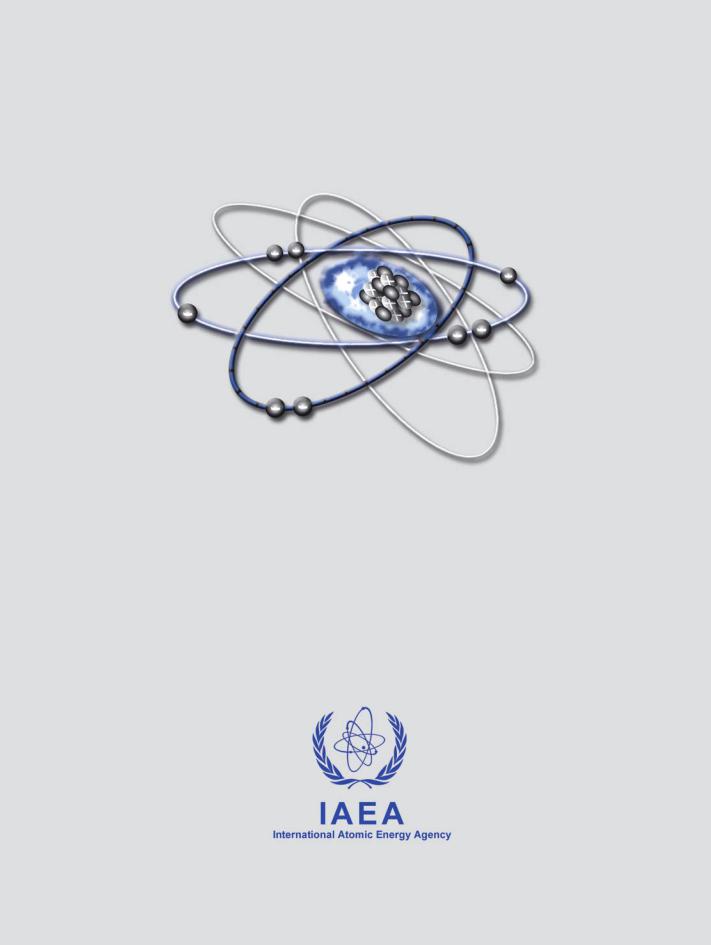
1radiation_people_and_the_environment
.pdf
Appendix A / Glossary
Risk factor The lifetime risk or radiation detriment assumed to result from exposure to unit equivalent dose or effective dose. Unit Sv-1.
Scintillation counter A device containing material that emits light flashes when exposed to ionizing radiation. The flashes are converted to electric pulses which are counted. The number of pulses is related to dose.
Sievert See effective dose and equivalent dose.
Silicon diode A device made of a silicon compound in which current flows when exposed to ionizing radiation. The current is converted to electrical pulses which are counted. The number of pulses is related to dose.
Thermal neutrons Neutrons in thermal equilibrium with the medium in which they exist, i.e. they have the same average thermal energy as the surrounding atoms or molecules. The average energy of neutrons at ordinary temperatures is about 0.025 eV, corresponding to an average velocity of 2.2 × 103 m/s.
Thermal reactor A nuclear reactor in which fission is induced predominantly by thermal neutrons.
Thermoluminescent material Material which, when heated, releases visible light in proportion to the amount of radiation to which it has been exposed.
Waste management All administrative and operational activities involved in the handling, treatment, conditioning, transport, storage, and disposal of radioactive waste.
Wavelength The distance between successive crests of an electromagnetic wave passing through a given material.
X ray Penetrating electromagnetic radiation emitted by an atom when electrons in the atom lose energy, and having wavelengths much shorter than those of visible light. Cf gamma ray.
RADIATION, PEOPLE AND THE ENVIRONMENT 77

Appendix B / Symbols and Units
Appendix B. Symbols and Units
Scientific notation
It is often more convenient to express the numbers encountered in radiological protection in scientific, rather than decimal notation because of their magnitude. This involves the use of significant figures within desired limits and multiplication by the appropriate power of ten. Examples are shown.
Decimal |
Scientific |
|
|
1 230 000 |
1.23 × 106 |
100 000 |
105 |
3 531 |
3.53 × 103 a |
15.61.56 × 101
0.239 |
2.4 × 10-1 b |
0.001 |
10-3 |
Prefixes |
0.000 087 |
8.7 × 10-5 |
Some powers of ten have special names and symbols. These may be prefixed to units of measurement: thus kilogram, symbol kg, for 103 gram; millimetre, symbol mm, for 10-3 metre. A table of prefixes follows.
Multiplier |
Prefix |
Symbol |
Multiplier |
Prefix |
Symbol |
|
|
|
|
|
|
101 |
deca |
da |
10-1 |
deci |
d |
102 |
hecto |
h |
10-2 |
centi |
c |
103 |
kilo |
k |
10-3 |
milli |
m |
106 |
mega |
M |
10-6 |
micro |
µ |
109 |
giga |
G |
10-9 |
nano |
n |
1012 |
tera |
T |
10-12 |
pico |
p |
1015 |
peta |
P |
10-15 |
femto |
f |
1018 |
exa |
E |
10-18 |
atto |
a |
1021 |
zetta |
Z |
10-21 |
zepto |
z |
1024 |
yotta |
Y |
10-24 |
yocto |
y |
RADIATION, PEOPLE AND THE ENVIRONMENT
Converting decimal to scientific notation
Notes:
a To three significant figures.
b To two significant figures.
Prefixes
79

Appendix B / Symbols and Units
Mass and atomic numbers:
carbon-14 by
146C
barium-140 by
14056Ba
lead-210 by
21082Pb
Table of common symbols in radiological protection
Relationship between old and new ionizing radiation units
Note:
aWas dose equivalent
Symbols
Symbols are used extensively in radiological protection. The elements are usually represented by symbols, for example, C for carbon, Ba for barium, and Pb for lead. It is usual to indicate the mass number and atomic number of a particular nuclide by a superscript and subscript. The atomic number is frequently omitted.
A table of common symbols follows. When the symbol for a unit is shown with a superscript of -1 on its right, it signifies that the quantity is being used in a fractional context or to represent rate. Thus, for example, sievert per hour can be written either as Sv h-1 or as Sv/h.
Symbol |
Term |
Symbol |
Term |
|
|
|
|
α |
alpha particle |
A |
mass number |
β |
beta particle |
eV |
electron volt |
γ |
gamma ray |
Bq |
becquerel |
e |
electron |
Gy |
gray |
p |
proton |
Sv |
sievert |
n |
neutron |
man Sv |
man sievert |
Z |
atomic number |
t1⁄2 |
half-life |
|
|
|
|
Units
Some time ago, the units for the main ionizing radiation quantities were changed to those used in this text. Readers may come across old units: this table shows how to convert them to the new units.
Quantity |
Old unit |
Symbol |
New unit |
Symbol |
Relationship |
|
|
|
|
|
|
|
|
Activity |
curie |
Ci |
becquerel |
Bq |
1 Ci = 3.7 × 1010 Bq |
|
Absorbed |
rad |
rad |
gray |
Gy |
1 rad = 0.01 Gy |
|
dose |
||||||
|
|
|
|
|
||
Equivalent |
rem |
rem |
sievert |
Sv |
1 rem = 0.01 Sv |
|
dosea |
||||||
|
|
|
|
|
80 RADIATION, PEOPLE AND THE ENVIRONMENT

Selected References
Selected References |
|
IAEA Publications |
www.iaea.org |
Radiation Protection and the Safety of Radiation Sources (Safety Fundamentals), |
|
Safety Series No. 120, IAEA, Vienna (1996). |
|
International Basic Safety Standards for Protection against Ionizing Radiation and for |
|
the Safety of Radiation Sources, Safety Series No. 115, IAEA, Vienna (1996). |
|
The Safety of Nuclear Installations (Safety Fundamentals), Safety Series No. 110, |
|
IAEA, Vienna (1993). |
|
The Principles of Radioactive Waste Management (Safety Fundamentals), Safety |
|
Series No. 111-F, IAEA, Vienna (1995). |
|
Low Doses of Ionizing Radiation: Biological Effects and Regulatory Control: Invited Papers |
|
and Discussions (Proceedings of a conference, Seville, Spain, 17-21 November 1997), |
|
Proceedings Series, IAEA, Vienna (1998). |
|
Legal and Governmental Infrastructure for Nuclear, Radiation, Radioactive Waste and |
|
Transport Safety (Safety Requirements), Safety Series No. GS-R-1, Vienna (2000). |
|
Preparedness and Response for a Nuclear Radiological Emergency (Safety Requirements), |
|
Safety Series No. GS-R-2, Vienna (2002). |
|
ICRP Publications |
www.icrp.org |
1990 Recommendations of the International Commission on Radiological Protec- |
|
tion, ICRP Publication 60, Ann. ICRP 21(1-3), Pergamon Press, Oxford and New York |
|
(1991). |
|
UNSCEAR Publications |
www.unscear.org |
UNSCEAR 2000 Report on Sources and Effects of Ionizing Radiation to the General |
|
Assembly (2 Volumes), United Nations, Vienna (2000). |
|
UNSCEAR 2001 Report on Hereditary Effects of Radiation to the General Assembly, |
|
United Nations, Vienna (2001). |
|
OECD/NEA |
www.nea.fr |
European Commission |
|
europa.eu.int/comm/energy/nuclear/index_en.html (nuclear safety and radioactive waste) |
|
europa.eu.int/comm/environment/radprot/index.htm (radiation protection) |
|
RADIATION, PEOPLE AND THE ENVIRONMENT

Printed by the IAEA in Austria, February 2004 IAEA/PI/A.75 / 04-00391
Division of Radiation and Waste Safety: A.D. Wrixon; I. Barraclough; M.J. Clark (Consultant)
Division of Public Information:
J.Ford (Editor); A. Diesner-Kuepfer (Design, Illustration and Layout);
B.Blann (Photo Support)
